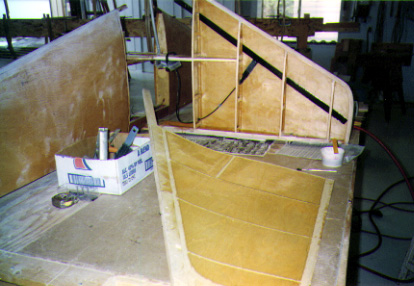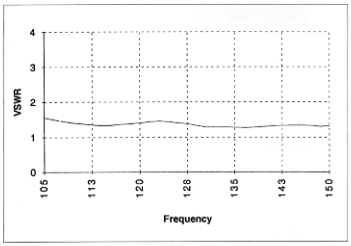The Antenna Wars
![]()
The Antenna Wars |
|
|
From "Construction Notes", Falco Builders Letter, March 1996 |
Jim Kennedy sent us some information on a high gain VHF antenna. This antenna is an alternative design to the type of antenna we supply in our kits, and I couldn't begin to comment on the merits of the two designs.

Jim Kennedy's antenna being installed
The antenna is the Model VHF-5T antenna, available for $149.00 from Advanced Aircraft Electronics, Inc., Box 4111, Florissant, MO 63032. Telephone: (800) 758-8632. This antenna is specifically designed to be installed inside the airframe and does not depend on a ground plane. They claim that the antenna is superior to all other designs on the market, and Jim Kennedy (who is an electrical engineer with a lifetime experience in telecommunications) says that this antenna will provide a noticeable improvement in the performance of the comm antenna. Jim says they will also work for nav as well, but on reception it's not as critical and that our present foil antennas are good.
Jim says the only problem he's experienced with the antennas is that they will break easily if bent too far. He found this out the hard way when he installed one between two ribs in the wing Other than that, Jim Kennedy has nothing but high praise for these antennas.-Alfred Scott
|
In our March issue, Jim Kennedy recommended the Model VHF-5T antenna available form Advanced Aircraft Electronics. His comments caught the watchful eye of Jim Weir, designer of the copper foil antennas that we use. Jim Weir offered the follow comments, which we forwarded to Jim Kennedy and Advanced Aircraft Electronics for their reply. All this stuff is over my head, so form your own opinion.-Alfred Scott |
Jim Weir Thrusts
Recent issues of this newsletter make claims for "new design antennas"
that have "high gain". As the inventor and proud papa of the 'copper
foil' style of antenna, I feel obligated to comment.
Radio systems and gardens have a lot in common. If you only have so much watter, you can sprinkle the whole garden with an equal amount of water, or you can get a nozzle that will put all the water into one corner of the garden and let the rest of the garden go dry. There is no 'magic wand' that makes more water. You can spread it out equally or you can put it all into one corner. It isn't rocket science to do either one.
The same is true of radios. You only have so much radio capability (power for transmitters, sensitivity for receivers). You can cover the whole area in every direction from the airplane, or you can squirt it all in one direction. All "gain" means is that you are using a nozzle to squirt the radio one direction or the other. Unfortunately, airplane antennas are fixed in position. You can't "point" the nozzle of a gain antenna without pointing the airplane at the same time. If you could always presume that your intended station was in one direction, designing an antenna to squirt all your energy in that direction would be child's play. That isn't the real world. You never know what azimuth a ground station is going to be relative to your airplane's nose so your "gain" antenna can only point in one direction at a time.
To say that an antenna will perform okay for nav (or receive only) but not for comm transmitters reveals a deep misunderstanding of antenna fundamentals. All antennas from Marconi's acre-sized arrays to the little patch antennas on the back of your cellular phone are 'reciprocal'. That is, the antenna has absolutely no idea whether it is being used for a transmitter or receiver. If you can show me a passive antenna (one without internal transistors and such) that has the slightest difference between transmitting and receiving, I can guarantee you a Nobel prize in physics.
The author of the referenced column is correct-prefabricated antennas on fiberglass will crack when bent. That is why RST Engineering has always and continually advocated the use of thin copper tape that bends, folds, and generally maneuvers around surfaces. We also maintain that paying $150 for an antenna that does nothing more than the ones we sell for less than $5 a copy is wasting good money that you could spend on other neat goodies for your airplane. I once watched a tanker truck full of gin pour its product into the bottling factory. First the truck disgorged half its load into the "red label" vat and then the second half into the "blue label" vat. When questioned, the truck driver just shrugged and said that some folks that paid double for the "blue label" swore the stuff tasted much, much better than the 'cheap stuff', even though it came from the same batch.
This is not so say that we don't have some new ideas that will make your foil antennas easier to install and perform just a bit better than the original designs of twenty years ago. After all, even Frati and LoPresti have come up with some new wrinkles in that time span. But like those honorable gentlemen, the basic design considerations of good airplanes and good antennas stand the test of time, and it is in the details that we advance the art.
Jim Weir
RST Engineering
Jim Kennedy Parries
Boy, taking on Jim Weir is like taking on God! I have sat through many of
his sessions at Oshkosh and have the highest regard for his talent and contributions
to avionics in sport aviation. I also agree with everything he said in his
response, i.e. (1) dipole aerials are all unity gain and non-directional,
and (2) transmit and receive are equally important.
However what he did not address was impedance matching the coax cable to the aerial (using his terms) so we don't have any restrictions in squirting the water (the signal) out the other end. Or delivering the water (receive the signal) over the entire wide aviation band.
The big question with the RST foil aerial is matching the 50 ohm coax cable to the 377 ohm radiating elements in free air. The ferrite rings around the coax cable out near the antenna act as chokes which absorbs the unradiated energy from reflecting the signal back to your radio. It makes the aerial very reasonable to make but not a very good match. But it works. This is probably why the term 'High Gain' was used by Advanced Aircraft. I would not use this term since only an active device has gain.
I am more convinced than ever that a manufactured aerial with precise length radials, balun coil, encapsulated and tested for impedance matching with a low vswr of 1:5 to 1 over the entire aircraft band is the best choice for the Falco. After all, we can't try it in the air until it's too late, and we can't change it easily. I have sold about 20 of these aerials and have about 10 flying, all with good results. I prefer the special-orders ones with the good quality RG58A/U coax cable encapsulated rather than a BNC connector you can't get to.
I notice the aerials are now being sold by Chief and Aircraft Spruce at a discount. I have arranged for a discount for Falco builders. The recommended VHF-5T with 20' cable potted is $129.00, while the standard VHF-5T is $119.00 ($149.00 list). Call 800-758-8632 and identify yourself as a Falco builder.
I don't think 3% of a radio cost is expensive. Matter of fact, I used one for nav also. We need to at least keep one good VOR ILS system up and running for a while. Yes, Jim, receive is important. Probably more so.
I have sent a copy of this to Bill Butters with Advanced Aircraft Electronics for his response.
Now, if I could only close by singing "God Bless America" as well as Jim Weir, I'd be a happy camper...
Jim Kennedy
Bill Butters Jousts
In the time that I've been a pilot, I've never seen a fellow pilot without
a strong opinion on any subject (even subjects in which he has no first-hand
information). Additionally, I never met a fellow engineer who didn't find
fault with anything and offer he could do better. Combine these two, and
offer a forum in which to express himself, and we have a newsletter editor's
delight.
It's not our policy to criticize our fellow manufacturer's products. The consumer community will do a very objective evaluation of all the products on the market, and the worthwhile products will survive. It's curious that someone would imply that our antennas are just a repackaging of the infamous tinfoil product. If I could offer an airplane product for only $5, I'd just give it away as a premium along with the purchase of another item.

Actually, I spent a lot of time engineering this antenna design to provide the builder with one less detail which could slow down his project's progress. The VSWR for either our comm or nav is excellent, and it only requires the builder's decision to mount it vertical for comm or horizontal for nav. (Hand-helds mount it at 45° for a good operation with both functions.) That's the good news. The bad news is that this design can be mounted in so many locations on the airframe that there's an even chance that the operation could be either excellent or poor. That's why we send along a 12-page instruction booklet and willingly spend our nickle on the phone to assist anyone in their installation.
I have to take credit for the brand name "High Gain". This one thing seems to annoy the engineer purist who takes exception and then uses everyone's time to explain basic antenna fundamentals to those who will listen. I selected the name as a marketing differentiator rather than a technical descriptor. Even my suppliers have suggested that I change the name. One suggested "Black Beauty", but this may run afoul of some governmental or sociopolitical association. Perhaps I should have a name-the-antenna contest.
Bill Butters
Advanced Aircraft Electronics
|
From "Mailbox" Falco Builders Letter, December 1997 |
Even though I'm not a Falco builders, I'd like to share my experience with you. I own a production Falco, Series II, from 1958. After buying the Garmin GPS/Com GNC250XL (which, by the way, is nothing short of excellent) I had a problem with both com transmitter and receiver range. After checking the com unit, antenna and wiring, I decided to try a different antenna, even though everything was found to be okay.
I followed Jim Kennedy's suggestion and bought an AAE VHF5T antenna. Obviously, I was not able to install it in the fin, which would probably be the best location, nor was I able to install it vertically in a straight line, because the fuselage is too small. So I did the somewhat less ideal half around the fuselage installation, which according to the manual is not the best way, but it made quite a difference.
The transmitter range and reception improved vastly. As I'm not a professional on this subject, I cannot discuss why my performance improved so much. I can only report what I did and what happened. So now you builders out there can find out which is the better antenna!
Oliver Barth
Hamburg
Germany